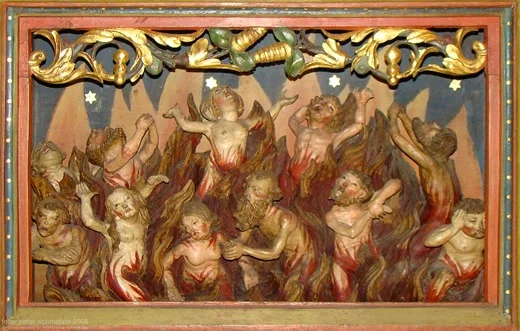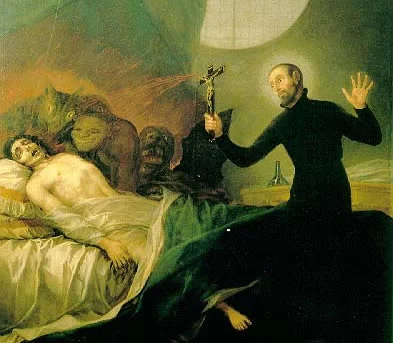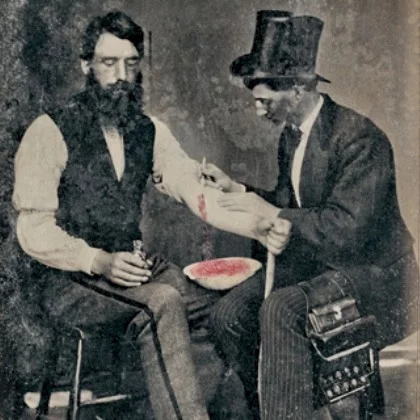Why Was the Phlogiston Theory Supported?
The phlogiston theory is a chemical hypothesis that was supported in the 18th century. According to this theory, all flammable materials contain an element called phlogiston and, when a substance is burned, its phlogiston is released and the remaining ash is held to be its true form. The background of the phlogiston theory was the desire for catharsis exemplified in witch-hunts and bloodletting in the early modern era. As to the former people thought burning witches at the stake could expel Satanism from them, lighten their sins as well as their physical weight and reduces them to their true forms. As to the latter they thought bloodletting could expel the cause of diseases from the body, lighten their symptom and reduce patients to their true healthy forms.

Contents
1. The rise and fall of phlogiston theory
The phlogiston theory is an obsolete chemical hypothesis that tries to explain why combustion changes substances. According to this theory, all flammable materials contain an element called phlogiston and, when a substance is burned, its phlogiston is released and the remaining ash is held to be its true form.
The phlogiston theory was first advanced by Johann Joachim Becher, a German chemist and physician, in 1667[1]. It was developed and popularized by Georg Ernst Stahl, a German chemist and physician, in 1697[2]. Becher named the flammable element terra pinguis, fatty earth in Latin, and Stahl renamed it phlogiston, a combustible element in Greek. The phlogiston theory received strong and wide support among the Western scientists throughout the 18th century.

According to this theory, substances lose weight when they are burned to ash because they have released phlogiston. Metals, however, turned out to gain weight when they were burned. Some phlogiston supporters insisted that phlogiston should have negative weight in this case, but it is too arbitrary to assume the weight of phlogiston positive or negative according as the sort of substances.
In 1783 Antoine Lavoisier, who proved the principle of conservation of mass, refuted the phlogiston theory[4] and proposed the oxygen theory of burning. Still some scientists such as Joseph Priestley adhered to the phlogiston theory. Even after the discovery of oxygen the concept of phlogiston was used to explain what we now call energy[5]. Why was this theory so attractive to those in the 18th century?
2. The relation to witch-hunts
Investigating the historical background of phlogiston theory, we will notice that the German witch-hunt reached its zenith when Becher advanced the phlogiston theory in 1667. The peak years of witch-hunts in southwest Germany, where he was born and lived, were from 1561 to 1670[6]. The large-scale witch trials and executions waned thereafter and the death sentence for witchcraft ended in German in 1775. Both the phlogiston theory and witch-hunts in Europe were over at the end of the 18th century.
The alleged witches were burned at the stake in Germany and most of other areas. The picture below depicts execution of witches in Switzerland in the 16th century. Those in the 18th century would thought the smoke ascending from witches should include phlogiston.

Death by burning had been the official punishment for heresy since the Roman Catholic Synod of Verona legislated in 1184. It was also the traditional punishment for women found guilty of treason (murder of her husband) in the United Kingdom. The Malleus Maleficarum, the most famous treatise on witches, first published in Germany in 1487, says that witches are burned at the stake because the majority of them are women[8].
Burning wounds was an Ancient medical treatment to disinfect them and stop bleeding. Since crime tears open a wound of a social system, it is symbolically significant for the power holder to burn the criminals at the stake so as to stop the aggravation of the wound and show off the recovery of the healthy social order. Fire has been the symbol of the male sex from ancient times and it is even more symbolically significant for the paternal religion such as Christianity to burn heretics at the stake who worship the maternal religion and women guilty of treason, especially female witches that meet these two conditions.
We can find the idea of purifying fire (purgatorius ignis) also in Catholic doctrine of purgatory, where souls could be purged from venial sins in life and achieve the holiness necessary to enter heaven.

The witches were thought to be polluted by Satanism and persecutors burned them at the stake in order to purge them from Satanism. So we can say it is a kind of exorcism. An exorcism is the act of driving out Satan, demons, evil spirits and the like from possessed persons.

If we interpret burning witches at the stake as an exorcism, we can find the origin of the phlogiston theory here. Burning witches at the stake expels Satanism from them, lightens their sins as well as their physical weight and reduces them to their true forms before they sold their souls to Satan. Generalization of this idea result in the phlogiston theory: burning materials expels phlogiston from them, lightens their weight and reduces them to their true forms before they are possessed by phlogiston.
3. The relation to antiphlogistic bloodletting
Another notable background of the phlogiston theory is bloodletting that was in fashion in those days. Bloodletting or phlebotomy is the withdrawal of blood from a patient in order to cure or prevent disease.

Note that both of the proponents of phlogiston theories, Becher and Stahl, were physicians. Physicians in those days attributed various sorts of diseases to excessive blood and surgeons or barbers were apt to resort to bloodletting in order to heal them.
It was observed that local infections healed when they burst and bled, so lancing was used to reduce local infection, referred to as an excess or “plethora" in Hippocratic terms. Similarly, bloodletting used to reduce extreme fevers was called antiphlogistic bloodletting. Antiphlogistic bloodletting and therapeutic seasonal bloodletting were common to many early traditional systems. Bloodletting fell out of practice in the West in the early twentieth century as a consequence of overzealous practice: the sicker the patient, the more the letting.[12]
Fever and inflammation are analogous to burning and phlogiston corresponds to blood. Becher and Stahl might think just as bloodletting lightened fever and inflammation and reduced patients to their true healthy forms, letting phlogiston out would lighten materials and reduce them to their true forms, nonflammable ash.
When a body is infected with pathogens such as bacteria and viruses, it causes inflammation, which is the response of the organism to remove the pathogens rather than a symptom caused by infection and results from the increased movement of plasma and leukocytes from the blood into the injured tissues. It is conceivable those who did not have such a medical knowledge attributed the red swell to an excess of blood and tried to allay inflammation by means of bloodletting. Discharging pathogens as well as blood might heal infections. It is natural that they applied bloodletting to lower fevers in general.
Of course it has no medical rationale that bloodletting is effective in the treatment of fevers in general. Bloodletting is used today in the treatment of only a few diseases such as hemochromatosis and polycythemia. Its practice was, however, performed by doctors from antiquity up to as late as the end of the 19th century because its catharsis effect in addition to a mere placebo effect had a positive mental influence on patients. A patient suffering from a high fever could be under the illusion that, seeing blood whose color is the same as that of fire spout from the wound, he or she was discharged from fever in combination with blood. The same logic was applied to other alleged causes of diseases as if bloodletting had been a panacea.
4. The age of catharsis
Witch-hunts hysteria reached its zenith during the 17th century, the phlogiston theory during the 18th century and bloodletting during the beginning of the 19th century. The period between the 17th century and the beginning of the 19th century coincided with the Little Ice Age when the Western people suffered from cold weather. A crop failure because of low temperature fomented social unrest. People made scapegoats of witches, purged them from the community (or strictly speaking, Satanism from them) and tried to reduce social entropy by the catharsis effects. As witch-hunts were too unscientific, they faded out in the 18th century. Still the desire for catharsis did not fade out and pseudo-scientific bloodletting thrived. Those who felt uneasy about causes of diseases being invisible made a scapegoat of visible blood and purged it from their bodies. The background of the phlogiston theory was the desire for catharsis exemplified in witch-hunts and bloodletting in the early modern era.
5. References
- ↑Johann Joachim Becher. Physica subterranea, 6.5 De Decompositis terreis, siccis & liquidis, pinguibus & macris. 1667. Universitäts- und Landesbibliothek Sachsen-Anhalt.
- ↑Georg Ernst Stahl. Zymotechnia fundamentalis sive fermentalionis theoria generalis. 1697.
- ↑The Engines of Our Ingenuity and Polarlys.
- ↑Antoine-Laurent Lavoisier. Réflexions sur le phlogistique pour servir de suite à la théorie de la combustion et de la calcination. publiée en 1777, Paris : Académie des sciences, 1783.
- ↑Allchin, Douglas. “Phlogiston After Oxygen." Ambix 39.3 (1992): 110-116.
- ↑H. C. Erik Midelfort. Witch Hunting in Southwestern Germany, 1562-1684: The Social and Intellectual Foundations. Stanford University Press (1972/6/1). p. 71.
- ↑Johann Jakob Wick. “Dietegen Guggenbühl: Hexen." Sandoz-Bulletin 24. 1971. p. 38.
- ↑Heinrich Kramer, Jacob Sprenger. The Malleus Maleficarum. Part I, Question I.
- ↑Peter Schmelzle. “Predella am Hochaltar der Stadtkirche Bad Wimpfen“. Licensed under CC-BY-SA.
- ↑Francisco Goya. “St. Francis Borgia Helping a Dying Impenitent." circa 1788.
- ↑Ryan Tracy. “Rare and Unusual Photos and Images From the Burns Archive." Newsweek. October 05 2010 8:00 AM.
- ↑Benjamin Kligler, Roberta Lee. Integrative Medicine. McGraw-Hill Education/Medical (2003/12/12). p. 184.





Discussion
New Comments
No comments yet. Be the first one!